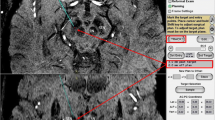Abstract
Background
Direct targeting of subthalamic nucleus (STN) without secondary electrophysiological verification during deep brain stimulation (DBS) is replacing atlas-based indirect targeting techniques. Recent groups have reported increased contrast and better delineation of STN and substantia nigra (SNr) in susceptibility-weighted imaging protocols (SWI). We aim to validate the STN-SNr boundary seen in MRI- SWI by correlating with intraoperative microelectrode recordings (MER) as a part of developing a multi-contrast DBS MRI planning protocol.
Methods
Prospective service evaluation involving electrophysiological verification by correlation of MER trajectory and STN-SNr boundary seen in SWI in seven consecutive patients undergoing DBS surgery were analyzed. The angle of inclination of the STN-SNr boundary and DBS trajectory in the coronal plane were calculated. Considering 4-mm dispersion of a coronal 3 MER array, we predicted, measured, and correlated the depths at which each electrode engaged the boundary.
Results
All central microelectrodes identified the STN-SNr boundary within 1 mm of the predicted depth with 100 % accuracy. Ninety percent of the lateral MER identified the STN-SNr boundary as predicted from SWI and angle of the encounter of the MER front.
Conclusions
The study demonstrates that STN morphology can be depicted using SWI MRI and coincides reliably with the electrophysiological MER boundary. Thus, this imaging modality can be used to refine STN direct targeting protocols in DBS surgery for PD.




Similar content being viewed by others
References
Abosch A, Yacoub E, Ugurbil K, Harel N (2010) An assessment of current brain targets for deep brain stimulation surgery with susceptibility-weighted imaging at 7 Tesla. Neurosurgery 67:1745–1756, discussion 1756
Balachandran R, Welch EB, Dawant BM, Fitzpatrick JM (2010) Effect of MR distortion on targeting for deep-brain stimulation. IEEE Trans Biomed Eng 57:1729–1735
Bejjani BP, Dormont D, Pidoux B, Yelnik J, Damier P, Arnulf I, Bonnet AM, Marsault C, Agid Y, Philippon J, Cornu P (2000) Bilateral subthalamic stimulation for Parkinson’s disease by using three-dimensional stereotactic magnetic resonance imaging and electrophysiological guidance. J Neurosurg 92:615–625
Benabid AL, Chabardes S, LeBas JF (2009) Subthalamic nucleus stimulation in Parkinson’s disease. In: Bain P, Aziz T, Liu X, Nandi D (eds) Deep brain stimulation. Oxford University Press, Oxford
Bonny J, Durif F, Bazin JE, Touraille E, Yelnik J, Renou JP (2001) Contrast optimization of Macaca mulatta basal ganglia in magnetic resonance images at 4.7 Tesla. J Neurosci Methods 107:25–30
Dormont D, Ricciardi KG, Tandé D, Parain K, Menuel C, Galanaud D, Navarro S, Cornu P, Agid Y, Yelnik J (2004) Is the subthalamic nucleus hypointense on T2-weighted images? A correlation study using MR imaging and stereotactic atlas data. AJNR Am J Neuroradiol 25:1516–1523
Egidi M, Rampini P, Locatelli M, Farabola M, Priori A, Pesenti A, Tamma F, Caputo E, Chiesa V, Villani RM (2002) Visualisation of the subthalamic nucleus: a multiple sequential image fusion (MuSIF) technique for direct stereotaxic localisation and postoperative control. Neurol Sci 23(Suppl 2):S71–S72
Elolf E, Bockermann V, Gringel T, Knauth M, Dechent P, Helms G (2007) Improved visibility of the subthalamic nucleus on high-resolution stereotactic MR imaging by added susceptibility (T2*) contrast using multiple gradient echoes. AJNR Am J Neuroradiol 28:1093–1094
Hutchison WD, Allan RJ, Opitz H, Levy R, Dostrovsky JO, Lang AE, Lozano AM (1998) Neurophysiological identification of the subthalamic nucleus in surgery for Parkinson’s disease. Ann Neurol 44:622–628
Slavin KV, Thulborn KR, Wess C, Nersesyan H (2006) Direct visualization of the human subthalamic nucleus with 3T MR imaging. AJNR Am J Neuroradiol 27:80–84
Starr P, Feiwell R, Marks W (1999) Placement of deep brain stimulators into the subthalamic nucleus: technical approach. Stereotact Funct Neurosurg 72:247
Theodosopoulos PV, Turner RS, Starr PA (2004) Electrophysiological Findings in STN and SNr. In: Israel Z, Burchiel KJ (eds) Microelectrode recording in movement disorder surgery. Thieme Medical Publishers, Inc., New York
Tuite PJ, Mangia S, Michaeli S (2013) Magnetic resonance imaging (MRI) in Parkinson’s disease. J Alzheimer Dis Res. doi:10.4172/2161-0460.S1-001
Volz S, Hattingen E, Preibisch C, Gasser T, Deichmann R (2009) Reduction of susceptibility-induced signal losses in multi-gradient-echo images: application to improved visualization of the subthalamic nucleus. Neuroimage 45:1135–1143
Young GS, Chen N-K (2007) High contrast susceptibility weighted imaging: Reliable Unwrapping Susceptibility Technique (RUST SWI) improved visualization of midbrain nuclei for deep brain stimulation. Proc Intl Soc Magn Reson Med 15:937
Author information
Authors and Affiliations
Corresponding author
Ethics declarations
Ethics Approval
This study was approved by Nottingham University Hospitals ethics committee and has been performed in accordance with the ethical standards laid down in the 1964 Declaration of Helsinki and its later amendments. All persons gave their informed consent prior to their inclusion in the study.
Conflict of interest
All authors certify that they have no affiliations with or involvement in any organization or entity with any financial interest (such as honoraria; educational grants; participation in speakers’ bureaus; membership, employment, consultancies, stock ownership, or other equity interest; and expert testimony or patent-licensing arrangements), or non-financial interest (such as personal or professional relationships, affiliations, knowledge or beliefs) in the subject matter or materials discussed in this manuscript.
Rights and permissions
About this article
Cite this article
McEvoy, J., Ughratdar, I., Schwarz, S. et al. Electrophysiological validation of STN-SNr boundary depicted by susceptibility-weighted MRI. Acta Neurochir 157, 2129–2134 (2015). https://doi.org/10.1007/s00701-015-2615-1
Received:
Accepted:
Published:
Issue Date:
DOI: https://doi.org/10.1007/s00701-015-2615-1




